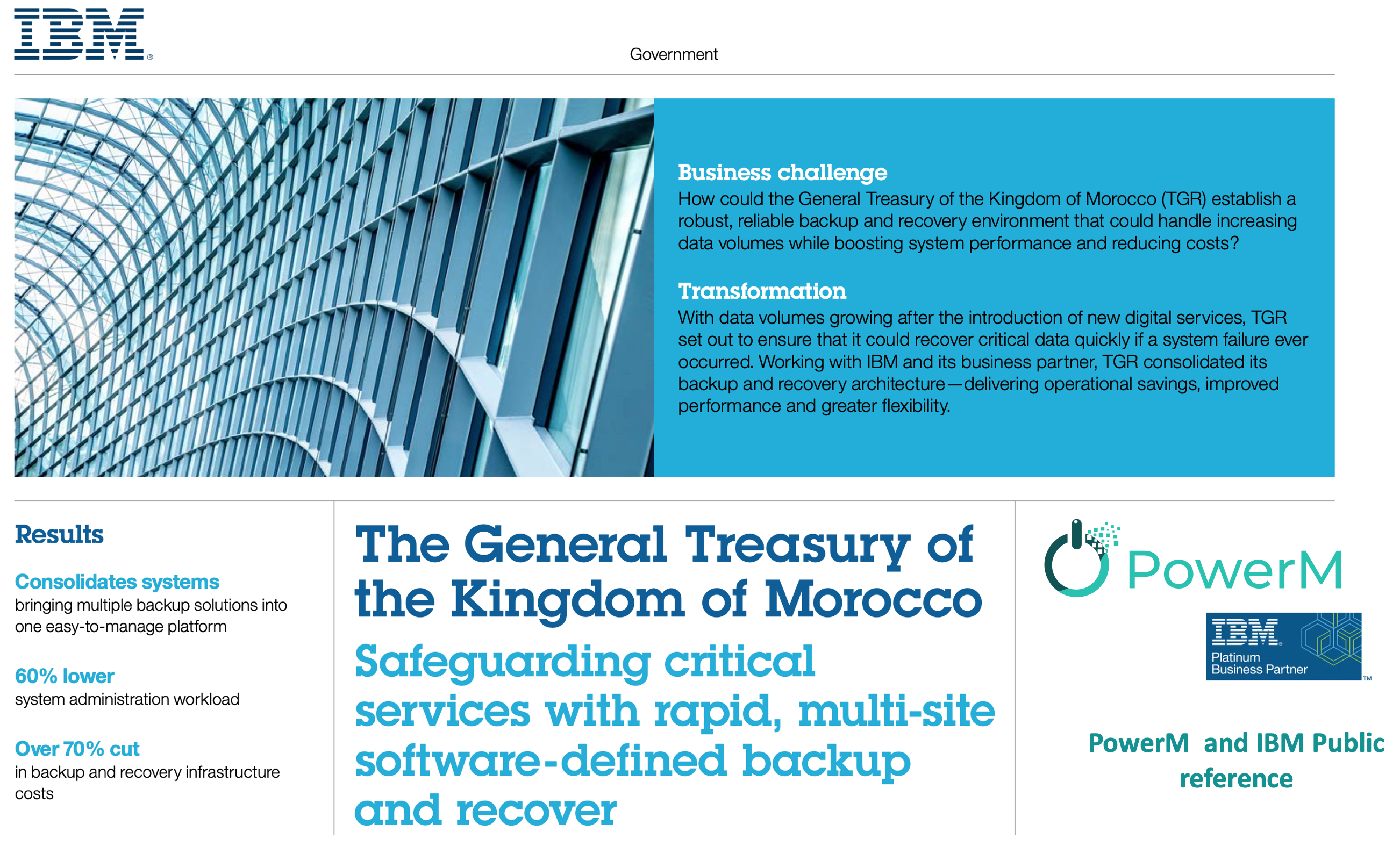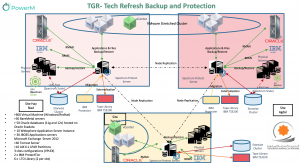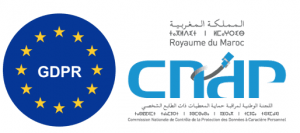
Safeguarding critical services with rapid, multi-site software-defined backup and recover Published 20 June 2019 – ID PM00011 – 12 min read
Responsible for overseeing all the financial and accounting activities of state and local authorities, TGR is one of the most important administrations of the Ministry of Economy and Finance. It is also at the center of an institutional network made up of public administrations, public institutions, local authorities and other major financial institutions all concerned with the management of public funds.
Managing national economies
To keep Africa’s sixth largest economy running smoothly, TGR must ensure that its internal and citizen-facing services, such as online tax payment solutions, salary payment systems and state budgeting apparatus, remain online 24 hours a day, seven days a week.
If system downtime occurs in its production environment, it is critical that the government organization can recover its core systems quickly and effectively, without any loss of data. But as data volumes increased following the introduction of new services, TGR recognized that its current backup and disaster recovery environment could no longer meet demands.
In recent years, TGR has undertaken a number of major digitization projects. While this move made its services much easier to use, it has also placed additional strain on the organization’s core IT systems, especially on its backup and recovery environment.
With multiple data backup and disaster recovery systems dedicated to individual business units, TGR recognized that its infrastructure had become increasingly complex and costly to maintain. If the government organization continued with this siloed approach, it foresaw that performance and recovery speeds would suffer.
Each department at TGR used different systems for the backup and recovery of critical environments, and the organization employed separate teams to manage these systems. This generated a significant amount of administrative effort and increased operational expenditure—an expense that would continue to increase as TGR’s hardware reached the end of its operational life.
What’s more, TGR’s system infrastructure had become increasingly complex to manage, especially given the large number of virtual machines (VMs) it uses. In particular, making copies of these VMs to create sandboxed development environments took a significant amount of time and occupied large amounts of disk space.
To optimize its IT infrastructure for backup and recovery, and to help developers work in a more agile way with VMs, TGR set its sights on establishing a software-defined storage infrastructure that would enable the institution to house all its backed-up data in a single environment distributed across multiple data centers.
TGR recognized that moving to a software-defined storage environment would not only reduce costs while extending the value of its existing hardware investment, but also streamline the process of creating development environments for software engineers working on innovation projects. What’s more, as a government agency, TGR is keen to set a high standard for compliance with the Moroccan Data Protection Act, so it’s essential that any changes it makes to its infrastructure can deliver benefits such as greater scalability and resiliency without compromising the ability to meet national regulatory standards.
Building a consolidated environment
To find the right technology for its infrastructure refresh project, TGR launched a request for proposal (RFP) and evaluated offerings from multiple vendors, including IBM.
IBM came out on top of all other vendors in TGR’s RFP. Not only could IBM deliver the versatile technology and the expertise required to upgrade the government organization’s backup and recovery environment, it was also able to do so in the shortest time and at the lowest cost.
Another differentiating feature of the IBM offering was a commitment to recovering data at a speed of 8 TB per hour—one of TGR’s core requirements for being able to bring systems back online rapidly if downtime does occur.
To increase storage capacity and backup performance, TGR deployed two IBM Storwize® V5000 storage arrays in each of its three data centers—two located at its Rabat headquarters and a third in Tangier.
TGR also uses IBM Storage Networking SAN24B-6 switches to connect its storage devices, with two switches installed in each of its three environments. The two data centers at TGR headquarters are architected for multi-site node replication with automated failover in an active-active arrangement. The third datacenter in Tangier acts as an additional failover point for these two data centers, providing additional resiliency.

In addition to harnessing the expertise of IBM Systems Lab Services and IBM Services, TGR worked with PowerM during the design and implementation of the solution.
IBM and PowerM helped the organization replace multiple backup and recovery systems with a single software- defined environment using Spectrum Protect software. With IBM Spectrum Protect Plus software, TGR enjoys ultra-fast data recovery—dramatically reducing the recovery time objective (RTO) for all core systems and applications in the organization.
Next-generation virtualization
To gain maximum value from its IBM Storwize investment and re-use its existing disk capacity, TGR relied on Spectrum Virtualize software, a solution built-in to the IBM Storwize devices, to present all systems as a single pool of virtualized storage for ultimate flexibility, and deployed Spectrum Scale software to support growing quantities of file and object data.
TGR further optimized its existing storage investment by transferring archived data from outdated physical tape libraries to disk storage using IBM Spectrum Archive software— removing the need for multiple tape management systems. With IBM Spectrum Control software providing one intuitive solution for monitoring all software-defined storage and the powerful infrastructure management tools in the Spectrum Protect solution, TGR can easily and conveniently manage storage across multiple hypervisors, application containers and virtual machines.
With hundreds of VMs stored in TGR’s backup environment architected on multi-vendor hypervisors, it was essential for the government organization to adopt a solution that can manage multiple virtualization solutions. Spectrum Protect Plus software meets this need perfectly, providing options for automation at every level while equipping system management teams with monitoring capabilities, such as a drilldown dashboard and proactive alerting.
PowerM provided expert technical support throughout the implementation project, providing custom patterns for the Spectrum Protect solution so that TGR could automate its core backup processes, including mission-critical Oracle databases on Exadata.
TGR has already identified plans to continue with its digitalization projects, with the ambition to go completely paperless by archiving key legal data in its backup environment. TGR is currently working on a proof of concept with IBM to test this idea and has already noted that IBM Spectrum Scale will be key to the success of this project.
Boosting resiliency and reducing costs
By consolidating its backup infrastructure into an ultra-scalable, flexible and reliable software-defined environment, TGR has significantly reduced the administrative burden for its disaster recovery infrastructure— simplifying system management and improving service quality.
By establishing a single system for backup and recovery and automating many administrative tasks with the Spectrum Protect solution, TGR has reduced its system administration workload by 60 percent. The organization previously had three distinct teams working with different tools. With Spectrum Protect software, TGR transitioned to one team managing the entire backup and recovery infrastructure. Concentrating the skillsets of system administrators in this way leads to better service quality, as administrators can build deep expertise in a single set of tools
TGR has measured an enormous improvement in the time required to complete backup processes—backing up large VMs now takes just 30 minutes, whereas previously it could take up to four hours. Similarly, backing up medium- sized VMs is achieved in only 15 minutes, which is a quarter of the time it took using the previous system. The company can also back up its Microsoft Exchange mailboxes in one hour, as opposed to eight hours in its old siloed environment.
With the Spectrum Protect solution giving system engineers a powerful set of management and monitoring tools, TGR’s technicians are able to perform more targeted and streamlined backups.
The Spectrum Protect Plus solution has given system admins the ability to search for the specific files or databases that they would like to recover from their systems—even inside VMs. Having such a detailed level of granularity enables TGR to respond faster and more flexibly to downtime in production environment. If a particular mailbox or virtual machine goes down in the production environment, users can just pull that specific system from backup environment and move it over to our production site without having to recover an entire database or virtual environment. And if TGR needs to recover all systems, it can prioritize the recovery of the most critical and time-sensitive systems first.
What’s more, TGR is using the Spectrum Protect Plus solution to streamline the cloning of existing VMs from its backup environment for use by development teams. Thanks to Spectrum Protect Plus software’s snapshots, these clones can be spun up from the backup repository, which is deduplicated and compressed, without doing a restore, reducing the pressure on primary storage infrastructure.
TGR has managed to make dramatic cost savings by establishing its single software-defined backup and recovery environment.With cutting-edge IBM technology powering its backup infrastructure, a lower administration workload and the ability to reuse existing storage hardware, TGR has been able to cut the overall costs of its environment by over 70 percent. The company has achieved this saving while also shrinking data center footprint by 50 percent, which has delivered further savings in energy and cooling.
Now that a cost-efficient, easy-to- manage backup and recovery solution sits at the heart of TGR operations, the organization is better placed than ever before to keep core systems running round the clock, even if TGR encounters disruption to its production systems. With a reliable and robust environment, it can offer citizens a wide range of convenient ways to engage with government financial services and systems.
About Power Maroc
Power Maroc is a Moroccan professional services and consulting corporation headquartered in Casablanca. The company provides disaster recovery planning, design and deployment services as well as systems implementation services for a wide range of private, hybrid, converged and hyper-converged infrastructures. To learn more, visit: powerm.ma
References
The General Treasury of the Kingdom of Morocco Safeguarding critical services with rapid, multi-site software-defined backup and recover https://www.ibm.com/downloads/cas/EPRKYZAP?mhsrc=ibmsearch_a&mhq=Morocco

